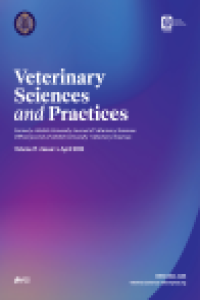Bolu Yöresindeki Bir Sürüde Botulismus Vakalarının İncelenmesi
Bu raporda Bolu yöresindeki bir sığır sürüsünde
tespit edilen Botulismus vakalarında klinik, hematolojik ve biyokimyasal
değişikliklerin belirlenmesi amaçlanmıştır.
Bu amaçla çalışmanın materyalini salgın sonucunda sağ kalan 10 sığır
oluşturdu ve bu sığırların klinik, hematolojik ve biyokimyasal muayeneleri
yapıldı. Anamnezde yetersiz mera koşulları nedeni ile tavuk gübresi ve tavuk
leşleri ile kontamine olmuş arazide otlayan sığırlarda 3 gün sonra ilk
semptomların ortaya çıktığı belirlendi. Klinik semptom olarak; sallantılı
yürüyüş, kas tremoru, dilin dışarı çıkması, kuyrukta paraliz, costo-sternal
yatma, ön ve arka bacaklarda paraliz belirlendi. Hematolojik muayenede bütün
parametrelerin referans değerler arasında olduğu tespit edildi. Biyokimyasal
incelemelerde serum kolesterol ve aspartat aminotransferaz (AST) değerleri
yüksek bulunurken bakır (Cu), demir (Fe), fosfor (P), mangan (Mn) ve selenyum
(Se) değerlerinin referans değerlerden düşük olduğu saptandı. Klinik olarak
Botulismus tanısı konulan sığırlarda hematolojik parametrelerde değişiklik
olmadığı belirlendi. Botulismustan
korunmak ve kontrol etmek için; toksin kaynağının engellenmesi ve yok edilmesi,
mera ıslahı, mineral takviyesi ve kadavraların uygun şekilde yok edilmesi ile
aşılama gibi tedbirlerin uygulanması gerektiği kanısına varıldı.
Anahtar Kelimeler:
Botulismus, Clostridium botulinum, Sığır
___
- 1. Bartlett JC., 1986. Infant botulism in adults. The New England Journal of Medicine, 315,254-255.
- 2. Böhnel H., Lube K., 2000. Clostridium botulinum and Bio-compost. A Contribution to the Analysis of Potential Health Hazards Caused by Bio-waste Recycling. Journal of Veterinary Medicine, 47, 785-795.
- 3. Stöber M., 2006. Krankheiten der Organe des zentralen Nervensystems. In” Dirksen Innere Medizin und Chirurgie des Rindes”. Ed., G Dirksen, HD Gründer, M Stöber, 5th ed., 1113-1118, Parey-Verlag, Berlin.
- 4. Große-Herrenthey A., 2004. Untersuchungen zu den Einflussfaktoren einer effizienten Bekämpfungsstrategie für Rinderbotulismus in Brasilien. PhD dissertation, University of Leipzig, Leipzig.
- 5. Gerlach T., 2007. Botulismus bei einer Golden-Retriever- Hündin. Tierärztliche Praxis, 35, 37-40.
- 6. Schiefelbein EB., 1986. Lebensmittelbedingte Infektionen und Intoxikationen der Jahre 1960-1983: Erfassung, Auswertung, Validität der WHO-Daten. PhD dissertation, University of Bonn, Bonn, Germany.
- 7. Monaco S., Freddi N., Francavilla E., Meneghetti F., Fenicia L., Franciosa G., 1998. Transient tonic pupils in botulism type Journal of the Neurological Sciences, 156, 96-98.
- 8. Van der Lugt JJ., De Wet SC., Bastianello SS., Kellerman TS., Van Jaarsveld LP., 1995. Two outbreaks of type C and type D botulism in sheep and goats in South Africa. The Journal of the South African Veterinary Association, 66, 77- 82.
- 9. Böhnel H., 1999. Botulismus – eine vergessene Erkrankung?. Berliner Münchener Tierärztliche Wochenschrift, 112, 139-145.
- 10. Braun U., Feige K., Schweizer G., Pospischil A., 2005. Clinical findings and treatment of 30 cattle with botulism. The Veterinary Record, 156, 438-441.
- 11. Kriek NPJ., Odendaal MW., 2004. Botulism. In “Infectious diseases of livestock with special reference to southern Africa Coetzer”, Ed., DR Thomson, RC Tustin, 1354-1371, Oxford University Press, Cape Town. Republic of South Africa.
- 12. Kraft W., Dürr UM., 1999. Klinische Labordiagnostik in der Tiermedizin, 5th ed., 344-363, Schattauer, Stuttgart.
- 13. Karagül H., Altıntaş A., Fidancı UR., Sel T., 2000. Klinik Biyokimya. 1. Baskı, 419, Medisan, Ankara, Türkiye.
- 14. Döbereiner J., Tokarnia CH., Langenegger J., Dutra IS., 1992. Epizootic botulism of cattle in Brazil. Deutsche Tierärztliche Wochenschrift, 99, 188-190.
- 15. Braun U., 2006. Botulismus beim Rind. Das Schweizer Archiv für Tierheilkunde, 148, 331-339.
- 16. Jean D., Fecteau G., Scott D., Higgins R., Quessy S., 1995. Clostridium botulinum type C intoxication in feedlot steers being fed ensiled poultry litter. Canadian Veterinary Journal, 36, 626-628.
- 17. Stöber M., 1990. In “Auswertung und Umsetzung der Untersuchungsbefunde”, Ed., GH Dirksen, D Gründer, M Stöber. Die klinische Untersuchung des Rindes, 3th ed. 647-662, Verlag Parey, Berlin.
- 18. Wilson RB., Boley MT, Corwin B, 1995. Prestumptive botulism in cattle associated with plastic-packaged hay. The Journal of Veterinary Diagnostic Investigation, 7, 167- 169.
- 19. Trueman KF., Bock RE., Thomas RJ., Taylor JD., Gren PA., Roeger HM., Ketterer PJ., 1992. Suspected botulism in threee intensively managed Australian cattle herds. Veterinary Record, 130, 398-400.
- 20. Senturk S., -Cihan H., 2007. Outbreak of botulism in a dairy herd in Turkey. Irish Veterinary Journal, 60, 481-484.
- 21. Çatık S., Akgül G., Mecitoğlu Z., Şentürk S. 2013. Bir Süt Sığır İşletmesinde Botulismus. Uludağ Üniversitesi Veteriner Fakültesi Dergisi, 32, 53-56.
- 22. Aytekin İ., Kaya F., Atalay H. 2016. Evaluation of serum haptoglobin, ceruloplasmin and pseudocholinesterase levels in cows with Botulism. Kafkas Üniversitesi Veteriner Fakültesi Dergisi, 22, 367-371.
- 23. Heider LC., McClure JT., Leger ER., 2001. Prestumptive diagnosis of Clostridium botulinum type D intoxication in a herd of feedlot cattle. The Canadian Veterinary Journal, 42, 210 -212.
- Başlangıç: 2022
- Yayıncı: Atatürk Üniversitesi
Sayıdaki Diğer Makaleler
Erzurum Yöresi Arıcılarının Karşılaştıkları Bal Arısı Hastalıkları
Malignant Meme Tümörlü Köpeklerde Plazma IGF-2 Konsantrasyonu ve Tümör Dokusundaki Ekspresyonu
Balıklarda Viral Enfeksiyonlara Karşı İmmun Sistemin İşleyişi
Bolu Yöresindeki Bir Sürüde Botulismus Vakalarının İncelenmesi
Türkiye’de Görülen Bal Arısı (Apis mellifera) Hastalıkları
Siyah Alaca İneklerde Güç ve Ölü Doğumun Takip Eden Laktasyon Performansına Etkisi
Buzağıların Sütten Kesim Öncesi Besleme Prensipleri
Malakan Atlarında Kalbin Arterial Vaskularizasyonu Üzerine Makroanatomik Bir Araştırma
